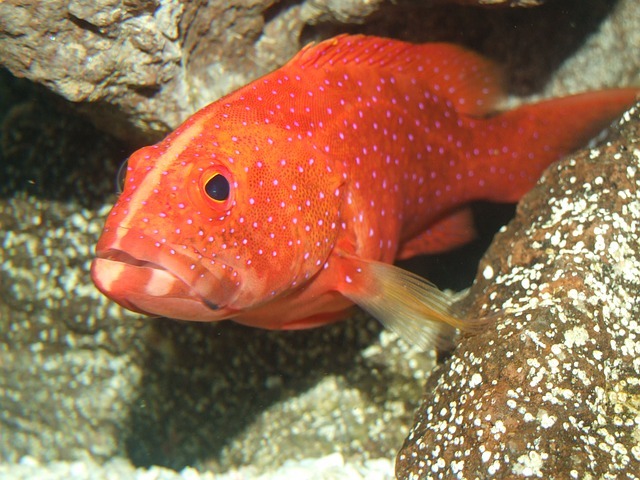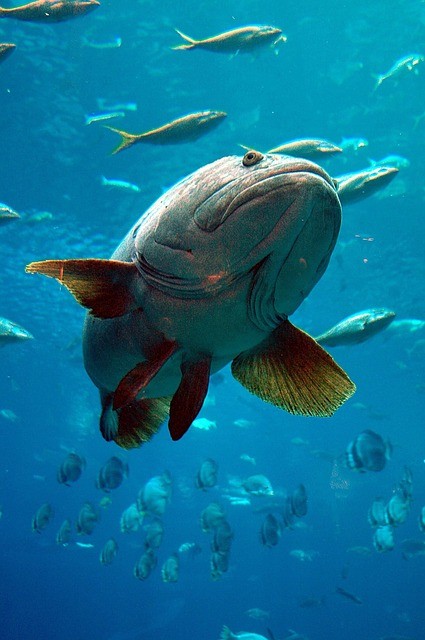Grouper fish, otherwise known as part of the Serranidae family, are a large saltwater carnivorous species with a wide variety in size and color.
They used to be big sport for those that enjoyed fishing, but their numbers have dwindled to less than 80% of what they used to be.
However, these big fish can live long and happy lives in a well-kept tank.
These are not small fish that can handle many smaller tankmates, and they have needs that differ from the more commonly kept pet fish.
The fact these guys can live from 10 to 13 years means you need to be fully aware of what committing to a Grouper fish entails.
Aside from their large size and lifespan, they are also immensely charming and intelligent, full of a personality unique only to them.
Unlike most other fish, a healthy Grouper fish will be able to look back at you when you look at them!
Contents
Grouper Fish Personality and Appearance
Size and Types
Grouper fish come in many different sizes and colors, but the fact remains that even smaller variations will grow to be quite large.
A medium tank designed for clownfish or seahorses won’t cut it for these impressive creatures.
The Six-Line is a type of Grouper fish that has a blue background to golden stripes, reaching 10 inches in length.
The Blue-Spotted is true to its name – blue with black spots outlined in white – that can be nearly 20 inches long.
The Panther Grouper fish is a soft brown, dotted with large spots that can assume a length of 27 inches.
Bearded Grouper fish are named for the little flap of skin that dangles from their lip like a beard, but the Bearded Grouper can also be called the Clown Grouper, as its one of the more colorful breeds with varied patterns of black, white, and orange.
Other purchasable Grouper fish include the Miniatus Grouper, the Red Flag/V-Tail Grouper, the Cherry Louti Grouper, the Saddleback Grouper, and the Blue-Line Grouper.
While these fish are often sold at a length of six inches, remember that they will all grow to be quite large, about 10 inches to 20 inches or more.
Make sure to thoroughly research the specific breed for the differences in behavior and size, as the uniqueness between each is not surface level only.
Health
Any carnivorous fish in captivity will be challenged by their lack of freedom to hunt. Reduced mobility means fewer calories burned, and due to this, they may gain more weight than they should.
Overweight fish are at risk of infection, tumors, and heart problems. Combat this by providing them mental and physical stimulation with toys or shared activities.
Any fish can develop exophthalmia, a condition where the cornea becomes cloudy and may have bubbles within the eye. This can be caused by trauma and is a result of gas in or behind the eye.
Often times, treatments to resolve the issue can be worse than letting the condition resolve itself through time, so it’s best to leave it alone.
If you suspect something in your aquarium has transmitted the sickness, then remove the item or fish and clean the tank.
Tankmates
Tankmates for Grouper fish should be centred around your individual species of Grouper, be it a Panther, Blue-Spotted, or otherwise.
For some, Angelfish and Triggerfish will be fine companions; for others, not so much. Here are the types of Groupers and who they’re comfortable hanging out with.
Panther Grouper
The Panther, contrary to what its name might imply, is relatively passive compared to the other Groupers.
They won’t mind most other fish so long as they’re not small enough to swallow. A strange condition for friendship, but that’s sea-life for you.
Here’s a video showing how to care for Panther Groupers.
Clown/Bearded Grouper
It’s not recommended that this particular Grouper be housed with other fish. When stressed or injured, they release toxins that may kill other life in the aquarium.
However, if the tank provided is large enough to dilute the toxins being released, you may get away with purchasing some buddies that are slightly larger than them.
Blue-Spotted Grouper
Any fish housed with a Blue-Spotted Grouper should be semi-aggressive or very aggressive fish by nature.
This will ensure the newcomers are able to fight back and defend themselves, putting the bully-like Grouper in its place.
Once the schoolyard squabbles are handled initially, the more grizzled tankmates should be fine going forward with few conflicts.
Grouper Fish Together
Unless you’ve purchased your Grouper fish with the intention of breeding them, buy two of the same gender and of different species of Grouper.
If you’re buying another Grouper after already owning one for a while, buy one that is just slightly larger than your current one.
The original Grouper will be aggressive to the newcomer at first, but despite a little friction between the two, they should be fine with each other – so long as there’s ample space and items for them both to interact with.
Grouper Fish Care
Tank Requirements
As these fish are big, they require a lot of space.
Some, like the smaller Blue-Spotted, can live well in a 135-gallon or 150-gallon tank, but much larger fish like the Panther will require a minimum of a 300-gallon tank due to their size.
If you plan to add any kind of tankmate, you’ll need an even bigger environment for them.
Because the best tankmates for Groupers are fish in similar or larger sizes than them, you’ll have to consider increasing the space available in the tank – but not just for comfort.
This also factors into the bioload each fish contributes and how much water you’ll replace each week when cleaning.
Water Requirements
The pH of the water in the tank should be from 8.2 to 8.4, at a temperature of 77° F to 81° F.
Remember to use saltwater, not fresh, when filling the tank.
Tank Set-Up
The method with which you introduce your fish into its new environment is just as important as setting up the tank.
If you intend on placing your Grouper fish in a tank with pre-existing fish, set them aside in a different tank for six weeks as quarantine.
Then rearrange the décor in the tank to break up any established habits or territories so your other fish won’t feel threatened by the newcomer.
Introduce the Grouper at night after you’ve typically turned off all your lights, so the other fish will begin settling down.
When you’re first placing your Grouper fish in the quarantine tank, fresh from the pet store, be sure to set the bag or container they arrived within in the new tank, allowing the water within the bag to slowly adjust to the tank water’s temperature. Once this adjustment has concluded, carefully open the bag and allow the fish to swim out, removing the bag entirely. Unlike some more delicate fish, there are no complicated extra steps involved.
Tank Maintenance
Alone, these fish have a heavy bioload in their environments.
Large with the appetite to match, they produce a great deal of waste that makes a supplemental filtration system a wise investment.
Make sure your tank has a generous amount of live rock, a protein skimmer, and a decent current within the water.
On top of that, consider investing in a large canister filter or a large power filter.
Remember to carry out weekly water changes as well. Depending on the bioload for your particular tank, it could mean replacing up to 50 percent of the water every week.
Grouper Fish Food
These fish should not be fed on algae flakes, but they can eat dried shrimp pellets.
Grouper fish are predators, needing a varied and full diet of meats such as scallops, shrimp, and squid. If you can’t get to your local seafood provider for fresh items, buy a variety of frozen baitfish.
Any kind of predator is going to be used to eating the whole fish, bones and bits included, so providing them with the whole animal helps maintain their health.
Even better, provide them with more live food, such as live brine fish or silverslides, than frozen or pre-prepared fish.
If you’re new to feeding fish a meaty diet and are unsure of how much to feed them, toss in what you think your Grouper might eat and watch for five minutes.
If they’ve eaten all you’ve provided, the next time you feed, add a little more and watch again. Any amount they eat after those five minutes should be the amount they’re fed daily.
Whatever they don’t eat beyond those five minutes should be removed from the tank to avoid any water quality or filtration problems.
Instructions on Feeding
If you’re used to dropping in some flakes for non-carnivorous fish, your first thought may be to just free-feed Groupers.
While that is something you can do, understand that Groupers are slightly more intelligent creatures than some marine fish and can be susceptible to boredom.
This makes live fish the most appealing option, but if you provide them with wiggling food they don’t eat right away, there’s no need to be alarmed. They could be saving it for later as a snack or plan to draw out the chase.
With non-live food, consider attaching it to a string and having it just touch the surface of the water. This creates curiosity in the Grouper who will proceed to stalk the food like it might a resting fly.
For introducing new food that your Grouper fish doesn’t seem too interested in, place it on a stick and insert it into the water.
Make sure the stick isn’t sharp and that it’s easy for your Grouper to remove; this creates the same curiosity.
Kabob skewers should be fine for this practice so long as the pointed end is removed and no splinters poke out.
Do you own any Grouper fish?







Thank you. We had a teacher leave and she left her fish. No one wanted it so I’m adopting it and getting ready to move it to my classroom. I’ve never had a fish like this before so your article was really helpful.